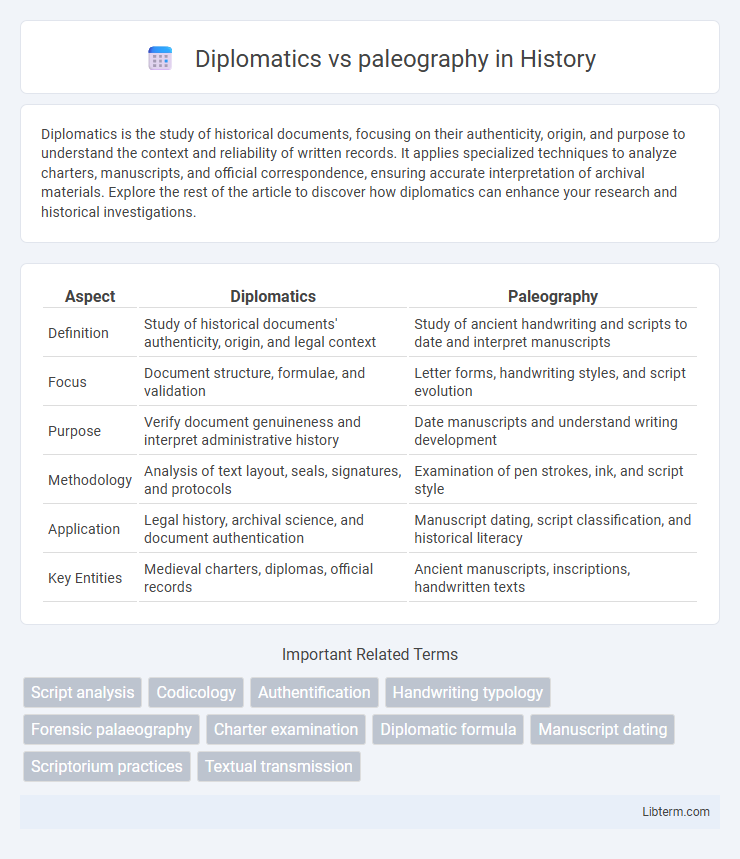Diplomatics is the study of historical documents, focusing on their authenticity, origin, and purpose to understand the context and reliability of written records. It applies specialized techniques to analyze charters, manuscripts, and official correspondence, ensuring accurate interpretation of archival materials. Explore the rest of the article to discover how diplomatics can enhance your research and historical investigations.
Table of Comparison
| Aspect | Diplomatics | Paleography |
|---|---|---|
| Definition | Study of historical documents' authenticity, origin, and legal context | Study of ancient handwriting and scripts to date and interpret manuscripts |
| Focus | Document structure, formulae, and validation | Letter forms, handwriting styles, and script evolution |
| Purpose | Verify document genuineness and interpret administrative history | Date manuscripts and understand writing development |
| Methodology | Analysis of text layout, seals, signatures, and protocols | Examination of pen strokes, ink, and script style |
| Application | Legal history, archival science, and document authentication | Manuscript dating, script classification, and historical literacy |
| Key Entities | Medieval charters, diplomas, official records | Ancient manuscripts, inscriptions, handwritten texts |
Introduction to Diplomatics and Paleography
Diplomatics is the critical study of historical documents aimed at authenticating and understanding their origin, purpose, and legal significance, while paleography focuses on the analysis and interpretation of ancient handwriting and scripts to date and contextualize manuscripts. Both disciplines are essential for historians, with diplomatics providing tools to evaluate the validity and function of documents and paleography offering techniques to decipher handwriting styles from different periods. Mastery of these fields enhances the understanding of archival materials, ensuring accurate historical reconstruction and textual analysis.
Defining Diplomatics: Scope and Objectives
Diplomatics is the scholarly discipline dedicated to the critical analysis and authentication of historical documents, focusing on their form, origin, and legal validity. It examines charters, diplomas, and official records to establish provenance and context, distinguishing authentic from forged documents. This field complements paleography, which primarily studies handwriting styles and scripts to date and localize manuscripts.
Paleography Explained: Focus and Methodology
Paleography focuses on the study and analysis of ancient handwriting and scripts to understand their evolution, style, and historical context. It employs detailed examination of letter forms, materials, and ink properties to date and authenticate manuscripts, providing insights into cultural and administrative practices. Unlike diplomatics, which centers on the analysis of documents' legal and functional aspects, paleography prioritizes the physical and stylistic characteristics of written texts.
Historical Development of Diplomatics
Diplomatics emerged in the 17th century as a systematic study of historical documents, focusing on authenticating charters, decrees, and official records through detailed analysis of form, script, and context. Unlike paleography, which primarily concentrates on the evolution and style of handwriting, diplomatics emphasizes the documentary content and legal validity, contributing significantly to verifying medieval and early modern manuscripts. This discipline developed alongside archival science, enhancing the understanding of administrative history and the bureaucratic practices of past societies.
The Evolution of Paleography as a Discipline
Paleography evolved from a supportive role in diplomatics to a distinct discipline focused on analyzing historical handwriting styles, scripts, and writing materials to date and authenticate manuscripts. By tracing the development of Greek and Latin scripts across centuries, paleographers established methodologies critical for understanding cultural and administrative history. The discipline now integrates digital tools and multispectral imaging to enhance the precision of script identification and textual interpretation.
Key Differences Between Diplomatics and Paleography
Diplomatics analyzes the authenticity, origin, and legal context of historical documents through content and format assessment, while paleography focuses on the study and interpretation of ancient handwriting styles and scripts. Diplomatics involves evaluating document structure, seals, and formulas to determine legitimacy, whereas paleography examines letter forms, ligatures, and writing materials to date and localize manuscripts. The key difference lies in diplomatics' emphasis on the document's function and validity versus paleography's concentration on script analysis and evolution.
Methodological Approaches: Diplomatics vs. Paleography
Diplomatics emphasizes the systematic analysis of historical documents' origin, authenticity, and legal validity through standardized protocols and criteria. Paleography focuses on the study and interpretation of ancient handwriting styles and scripts to date and contextualize manuscripts. Both methodologies employ complementary techniques, with diplomatics prioritizing document content and form, while paleography centers on graphic features and script evolution.
Practical Applications in Historical Research
Diplomatics analyzes the authenticity and legal context of historical documents, aiding historians in verifying charters, treaties, and official records for accurate interpretation of political and administrative history. Paleography focuses on the study of ancient handwriting styles and scripts, enabling researchers to date manuscripts and decode diverse scripts, essential for reading and transcribing historical texts. Together, these disciplines enhance historical research by providing critical tools for document authentication, chronological classification, and textual analysis.
Interdisciplinary Connections and Overlaps
Diplomatics and paleography intersect through their mutual focus on historical documents, with diplomatics analyzing the form, authenticity, and context of charters, while paleography deciphers handwriting styles and script evolution. Both disciplines utilize codicology and archival science to interpret manuscript structures and provenance, fostering interdisciplinary collaboration in historical research and preservation. Advances in digital humanities tools enhance their synergy by enabling detailed script analysis and metadata extraction for comprehensive documentary studies.
Future Trends in Diplomatics and Paleography
Future trends in diplomatics emphasize the integration of artificial intelligence and machine learning to enhance document authentication and historical data analysis. Paleography is evolving with digital imaging technologies and 3D modeling, enabling more precise script recognition and manuscript conservation. Collaborative platforms combining diplomatics and paleography foster interdisciplinary research, improving the interpretation of historical documents through advanced computational tools.
Diplomatics Infographic

 libterm.com
libterm.com